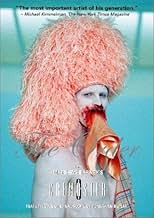IMDb RATING
6.9/10
1.6K
YOUR RATING
The third film of a five-part art-installation epic -- it's part-zombie movie, part-gangster film.The third film of a five-part art-installation epic -- it's part-zombie movie, part-gangster film.The third film of a five-part art-installation epic -- it's part-zombie movie, part-gangster film.
Peter Donald Badalamenti II
- Fionn MacCumhail
- (as Peter D. Badalamenti)
Todd Christian Hunter
- Mason
- (as Todd Hunter)
- Director
- Writer
- All cast & crew
- Production, box office & more at IMDbPro
Featured reviews
Though Matthew Barney doesn't identify himself as a filmmaker per se -- he's a sculptor by training and practice -- his Cremaster Cycle has me convinced that he has a more expansive vision for the possibility of cinema than any new director since Godard grabbed the audience by the hair and pulled us behind the camera with him.
I think part of Barney's resistance to the filmmaker label is that, like the rest of the world, he's been conditioned to believe that movies are only intended to serve a limited set of purposes, namely to act as filmed imitations of ankle-deep novels or plays; that a literal narrative, propelled throughout by actors talking, is the essential element of any movie. This model has been so deeply embedded in all of our psyches that even when a guy like Barney says "f*&^k all that" and defies every conceivable convention, he still feels as though he's doing something which is only nominally a film, even if it is in fact the opposite: a fully realized motion picture experience.
For those who don't know, The Cremaster Cycle is Barney's dreamlike meditation on ... well, I guess it'd be up to each viewer to decide exactly what the topics are, since the movies deliberately make themselves available for subjective interpretaton. Clearly Barney has creation and death on his mind, as well as ritual, architecture and space, symbolism, gender roles, and a Cronenbergian fascination with anatomy.
The movies are gorgeously photographed in settings that could only have been designed by someone with the eye of a true visual artist. In the first half of "3," Barney reimagines the polished interiors of the Chrysler Building as a temple in which the building itself is paradoxically conceived. The second half, slightly more personal, has Barney's alter ego in garish Celtic dress scaling the interior of a sparse Guggenheim Museum, intersecting at its various levels what are presumably various stages of his own artistic preoccupations -- encounters with dancing girls, punk rock, and fellow modern artist Richard Serra, among others.
In the end, what kind of movie is it? It certainly isn't the kind of movie that'll have Joel Silver sweating bullets over the box-office competition. Nor is it likely that more than three or four Academy members will see it, though nominations for cinematography and art direction would be well-deserved. It sure isn't warm and fuzzy: for my money, it might be a little too designed, too calculated. I always prefer chaotic naturalism over studious control. Friedkin over Hitchcock for me. It *is* the kind of movie that the most innovative mainstream filmmakers will talk about ten and twenty years from now when asked what inspired them. Barney's willingness to work entirely with associative imagery, to spell out absolutely nothing, and to let meaning take its first shape in the viewer's imagination, is the kind of catalyst that gives impressionable young minds the notion they can do something they didn't before think possible.
I think part of Barney's resistance to the filmmaker label is that, like the rest of the world, he's been conditioned to believe that movies are only intended to serve a limited set of purposes, namely to act as filmed imitations of ankle-deep novels or plays; that a literal narrative, propelled throughout by actors talking, is the essential element of any movie. This model has been so deeply embedded in all of our psyches that even when a guy like Barney says "f*&^k all that" and defies every conceivable convention, he still feels as though he's doing something which is only nominally a film, even if it is in fact the opposite: a fully realized motion picture experience.
For those who don't know, The Cremaster Cycle is Barney's dreamlike meditation on ... well, I guess it'd be up to each viewer to decide exactly what the topics are, since the movies deliberately make themselves available for subjective interpretaton. Clearly Barney has creation and death on his mind, as well as ritual, architecture and space, symbolism, gender roles, and a Cronenbergian fascination with anatomy.
The movies are gorgeously photographed in settings that could only have been designed by someone with the eye of a true visual artist. In the first half of "3," Barney reimagines the polished interiors of the Chrysler Building as a temple in which the building itself is paradoxically conceived. The second half, slightly more personal, has Barney's alter ego in garish Celtic dress scaling the interior of a sparse Guggenheim Museum, intersecting at its various levels what are presumably various stages of his own artistic preoccupations -- encounters with dancing girls, punk rock, and fellow modern artist Richard Serra, among others.
In the end, what kind of movie is it? It certainly isn't the kind of movie that'll have Joel Silver sweating bullets over the box-office competition. Nor is it likely that more than three or four Academy members will see it, though nominations for cinematography and art direction would be well-deserved. It sure isn't warm and fuzzy: for my money, it might be a little too designed, too calculated. I always prefer chaotic naturalism over studious control. Friedkin over Hitchcock for me. It *is* the kind of movie that the most innovative mainstream filmmakers will talk about ten and twenty years from now when asked what inspired them. Barney's willingness to work entirely with associative imagery, to spell out absolutely nothing, and to let meaning take its first shape in the viewer's imagination, is the kind of catalyst that gives impressionable young minds the notion they can do something they didn't before think possible.
Giant orges on an island. Punk bands dueling in the Guggenheim museum . Secret orders in New York's Chrysler building. Welcome to the ornate world of Cremaster 3, the third act in the `Cremaster Cycle' that plays out like a David Lynch film on crack. Or I should say reallllly drawn out David Lynch film on crack, as molasses would move faster then a lot of these scenes. At 3 and a half hours; with no dialogue, the pacing of a glacier melt, and some of the most jarring and horrific scenes ever captured on film
this one is definitely for the more patient art house film buffs. Directed and conceived by avant garde artist Matthew Barney, this film gives new meaning to the word cryptic. Think Mulholland Drive, Lord Of The Rings, and Koyaanisqatsi meets The Cell, From Hell, and a Marilyn Manson video. With some of the most rich cinematography ever, beauty is juxtaposed with labor and shock. Cremaster 3 is at once grotesque yet intriguing
a film that I found at times to be both hypnotic, funny, tedious; yet at other times downright frightening. Using a highrise as a metaphor, with each layer revealing yet another painstaking piece of the aria, the film comes full circle. And at completion, it cannot be denied; yet baffling, cryptic and exhausting would be more of the right description.
Matthew Barney's "Cremaster" series of 5 feature-length videos are an exploration of this artist's various interests. He's basically interested in everything, and manages to squeeze everything into this series. "Cremaster 3" is the centerpiece, wherein architecture, Freemason ritual, and folklore (Irish, Irish-American, American) take center stage. Barney offers little insight into his interests, simply presents them, overlaps them, as if he just made a list of stuff he likes and then visualized them. Luckily, his visual sense is utterly dazzling and eloquent. As a director, he is undoubtedly indebted to Kubrick and Hal Ashby. The images are elegant but pungent, finely polished but visceral and even gory in parts. The tone of the video, however, is deceitful (for lack of a less harsh word), suggesting a story or plot that doesn't really exist, or is so buried in the visual splendor as to be insignificant. It could be seen as a puzzle, but, in Barney's own words (according to the DVD commentary of "The Order" segment of "3"), it is merely a series of illustrations of ideas that have already been well drawn out (ie. Freemason ritual). Still it's worth watching, and listening to as well. Jonathan Bepler's score is truly gorgeous, reminiscent of Danny Elfman but even more haunting.
The previous reviewer obviously had no comprehension or understanding of this gloriously complex and evocative film. Cremaster 3 not only expands on themes and references explored in the previous four films but takes Barney's magical and hermetically sealed universe to new heights. The first half of the film takes place in a reconstruction of the Chrysler building, where the gender-transformed body of Gary Gilmore is unearthed and placed inside a classic chrysler car and destroyed by a fleet of other chryslers in a ritualistic demolition derby. Barney meanwhile scales the liftshaft of the building, filling one of the lifts with mud, eventually arriving at the exclusive Cloud Club where a group of masonic henchmen drink guinness. Meanwhile a mysterious woman slices potatoes with blades attached to her shoes. The second half of the film takes place in the Guggenheim museum where the levels of the museum are transformed into strange transmissions of all the previous films. Barney scales the levels of the museum interacting with the players on the different levels. On the final level is Richard Serra, recreating his famous thrown lead sculptures with melted vaseline.... Yes - it is weird, but wonderfully so. Barney is no doubt one of the most important contemporary artists around and Cremaster 3 is the final, remarkably assured piece of a puzzle that has excited and beguiled for the last 8 years and forces us to reinterpret the boundries between cinema, sculpture and performance art. A masterpiece!
This film is painfully boring! It's also way too long. It was so bad that I started staring at the walls and ceiling of the theater rather than look at the screen. Not one moment of each inexplicable sequence really resonated with me in the slightest. I think at least eight or more people left the theater before it was finished.
There is no plot at all. That in itself doesn't bother me, I don't think that a film necessarily has to have a narrative structure. However, the way in which this was done just didn't work for me. I've seen a lot of comparisons to David Lynch in people's comments. I personally don't see it. I love most of Lynch's films.
It seemed like the sort of film that an autistic person would make, cold and lifeless with no discernible emotion. The film treats inanimate objects and people almost as if they were the same. There is very little humanity or empathy to be found anywhere. Not to mention that there's no dialog.
I just couldn't relate to it at all.
There is no plot at all. That in itself doesn't bother me, I don't think that a film necessarily has to have a narrative structure. However, the way in which this was done just didn't work for me. I've seen a lot of comparisons to David Lynch in people's comments. I personally don't see it. I love most of Lynch's films.
It seemed like the sort of film that an autistic person would make, cold and lifeless with no discernible emotion. The film treats inanimate objects and people almost as if they were the same. There is very little humanity or empathy to be found anywhere. Not to mention that there's no dialog.
I just couldn't relate to it at all.
Did you know
- GoofsAfter the teeth have begun to exit the Apprentice's prolapsed intestine, there is an overhead shot of the hitmen standing around the Apprentice on the dentist's chair. The view of the intestine is slightly blocked by the back of one of the hitmen, but as he shifts from side to side, the teeth are nowhere to be seen.
- ConnectionsEdited into The Cremaster Cycle (2003)
- How long is Cremaster 3?Powered by Alexa
Details
Box office
- Gross US & Canada
- $120,308
- Opening weekend US & Canada
- $9,787
- May 21, 2010
- Runtime3 hours 2 minutes
- Color
- Sound mix
Contribute to this page
Suggest an edit or add missing content






























